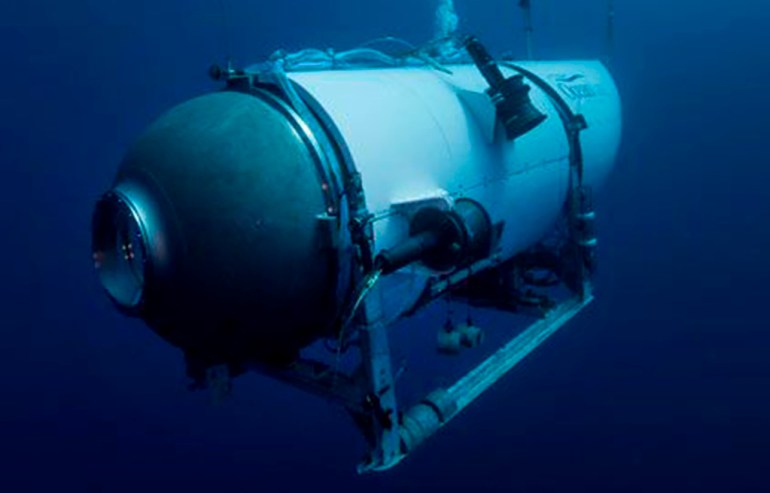The five-person Titan submersible missing in the North Atlantic is reported to have a 96-hour oxygen supply.
The United States Coast Guard is leading the search for the small craft, named Titan, in the remote North Atlantic Ocean where the Titanic struck an iceberg and sank in 1912, killing all but about 700 of the roughly 2,200 passengers and crew.
OceanGate Expeditions, a company based in the US state of Washington that deploys crewed submersibles for deep-sea expeditions, said that its vessel was the subject of the rescue operation.
The Titan’s dive on Sunday was one of many that have been made to the Titanic wreck by OceanGate since 2021.
Here’s what we know so far:
When and where did the Titan go missing?
- The search is being conducted approximately 1,450km (900 miles) east of the Cape Cod peninsula in a water depth of roughly 3,900 metres (12,800 ft), according to the US Coast Guard.
- The Titan began its journey on Sunday morning and its support vessel – the Polar Prince – lost contact with it about an hour and 45 minutes later.
- US and Canadian rescue ships and planes have swarmed the search area and some have dropped sonobuoys that can monitor to a depth of 3,900 metres (12,800 ft).
The Polar Prince and @Rescue106 will continue to do surface searches throughout the evening.
Two C-130 flights have been completed from @USCG CG Air Station Elizabeth City.@hfxjrcc Surface/subsurface search by Canadian P8 Poseidon aircraft to continue in the morning.
— USCGNortheast (@USCGNortheast) June 20, 2023
- Unlike submarines that leave and return to port under their own power, submersibles require a ship to launch and recover them.
- The Titan was launched from the Polar Prince, an icebreaker hired by OceanGate that ferries people and the submersible craft to the North Atlantic wreck site where multiple dives have been conducted.
- The Titan has a 96-hour oxygen supply, David Concannon, an adviser to OceanGate, told The Associated Press on Monday.
What kind of deep-sea vessel was it?
- The Titan is capable of diving 4,000 meters (13,120 feet) “with a comfortable safety margin”, according to documents filed by the company in April with a US District Court in Virginia that oversees Titanic matters.
- The Titan is made of “titanium and filament wound carbon fibre” and has proven to “withstand the enormous pressures of the deep ocean”, according to OceanGate.
- In a May 2021 court filing, OceanGate said the Titan had an “unparalleled safety feature” that assesses the integrity of the hull throughout every dive.
- The Titan had undergone more than 50 test dives, including to the equivalent depth of the Titanic, in deep waters off the Bahamas, the company said.
- During its 2022 expedition, OceanGate reported that the submersible had a battery issue on its first dive and had to be manually attached to its lifting platform, according to a November court filing.

What was the Titan’s mission?
- The goal of OceanGate’s expeditions has been to chronicle the Titanic’s deterioration as well as the underwater ecosystem that shipwrecks often spawn.
- What is left of the Titanic is slowly succumbing to metal-eating bacteria that consumes hundreds of kilograms of iron each day. Some have predicted the the wreck of the Titanic could vanish in a matter of decades.
- OceanGate outfitted the Titan with high-definition cameras and multi-beam sonar equipment. Charting the wreck’s decomposition can help scientists predict the fate of other deep-sea wrecks.
- “The ocean is taking this thing, and we need to document it before it all disappears or becomes unrecognisable,” Stockton Rush, president of OceanGate Expeditions, told the AP in 2021.
— OceanGate Expeditions (@OceanGateExped) June 19, 2023
Who was on board?
- The US Coast Guard said there was one pilot and four “mission specialists” onboard.
- OceanGate’s expeditions to the Titanic wreck site include archaeologists and marine biologists. The company also brings people who pay to come along. Known as “mission specialists”, such people take turns operating sonar equipment and performing other tasks in the five-person submersible.
- Pakistani businessman Shahzada Dawood and his son, Suleman, were on board, their family said in a statement. “We are very grateful for the concern being shown by our colleagues and friends and would like to request everyone to pray for their safety,” the statement said. UK billionaire businessman Hamish Harding was also said to be one of the mission specialists, according to Action Aviation, a company for which Harding serves as chairman.
- The expeditions, which cost $250,000 per person, start in St John’s, Newfoundland, before heading out approximately 640 km (400 miles) into the Atlantic to the wreckage site, according to OceanGate’s website.
- The expedition was OceanGate’s third annual voyage to chronicle the deterioration of the Titanic. An initial group of tourists in 2021 paid $100,000 to $150,000 apiece to go on the trip.
- Harding’s stepson wrote on Facebook that Harding had “gone missing on submarine” and asked for “thoughts and prayers”. The stepson subsequently removed the post, citing respect for the family’s privacy.
- Harding himself had posted on Facebook that he would be onboard the sub. The expedition headed out to sea on Friday, and the first dive was set for Sunday morning, according to Harding’s post.

- Harding holds three Guinness World Records, including longest duration at full ocean depth by a crewed vessel. In March 2021, he and ocean explorer Victor Vescovo dived to the lowest depth of the Mariana Trench. In June 2022, he went into space on Blue Origin’s New Shepard rocket.
